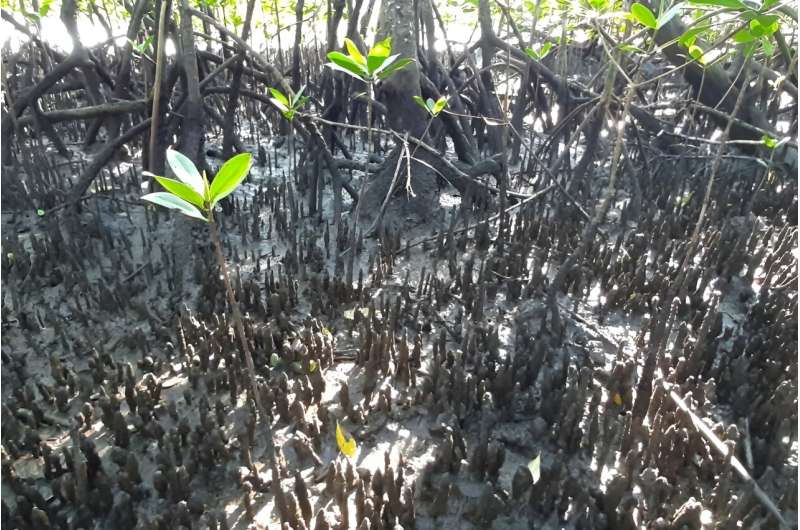This article has been reviewed according to Science X's editorial process and policies. Editors have highlighted the following attributes while ensuring the content's credibility:
fact-checked
peer-reviewed publication
trusted source
proofread
Rare long-distance dispersal events found to help maintain genetic structure of mangroves

In Brazil's North region, members of the population of red mangrove trees (Rhizophora mangle) do not often meet relatives from the South and vice-versa. However, occasional migrations via ocean currents between the two regions involving propagules, seeds adapted to seawater, enable populations to exchange genetic material and remain connected during their evolution.
This is one of the conclusions of a study reported in the journal Molecular Ecology Resources by Brazilian and Japanese researchers.
Mangrove forests form a unique wetland ecosystem, inhabiting the edge of land and sea, rooted and thriving in seawater. Mangroves play a vital role in coastal ecology and in sustaining and securing coastal communities.
Rhizophora is one of the main mangrove genera, found in all regions of the planet, and red mangrove is distributed in estuarine ecosystems throughout the tropics. Transoceanic dispersal and the cosmopolitan presence of the genus make it a good model for in-depth analysis of coastal ecology. Studies of red mangroves in Brazil can also help prioritize conservation areas, as they are important nurseries for various marine species and store large amounts of carbon.
"Research along these lines helps identify places where mangroves are releasing many propagules in both the North and Northeast and the South and Southeast of Brazil. It could be worthwhile creating conservation units in these areas," said André Guilherme Madeira, first author of the article.
"We collected DNA samples from trees of the species all over Brazil. The genetic data matched simulations of ocean currents, which also showed that propagules aren't carried very far from their parent mangroves. In sum, we have two practically isolated populations, one in the North/Northeast and the other in the South/Southeast," said Gustavo Maruyama Mori, last author of the article and a professor at IB-CLP-UNESP.
The study served as the basis for the project "Evaluating adaptation, epigenetic variation, and dispersal to unveil the response of mangrove in a changing world."
Cross-referenced data
Mangrove propagules are not in fact seeds properly speaking, but embryos that become fully mature plants before dropping off the parent tree. They are dispersed by water until they embed in the shallows. They can survive for about a year in saltwater, freshwater or brackish water before germinating. In Rhizophora, they are green, cylindrical and pointed. They are commonly found floating in the sea near beaches in Brazil.
Using mathematical models of floating and ten-year ocean current data, the researchers simulated propagule dispersal at 11 sites along the coast of Brazil, from Salinópolis, Pará state, in the North to Florianópolis, Santa Catarina state, in the South. In the simulations, propagules were assumed to germinate whenever they stopped on the coast in the period 2010-20.
"Red mangrove populations in Brazil are fairly isolated. They don't communicate with each other. However, one or another propagule occasionally reaches an ocean current that takes it farther than usual. These long-distance dispersal events are rare but can be significant," Madeira said.
The hypothesis was compatible with the genetic data, which showed an ancestral connection between the populations on a scale of thousands of years but little or none in recent generations.
Other more variable factors, such as coastal currents and air dispersal of pollen, may contribute to an exchange of genetic material between populations, complementing the hypothesis, but data is not available for these parameters in the populations analyzed to confirm the possibility.
The researchers now plan to apply the same approach to mangroves in other parts of the world, this time cross-referencing data from oceanographic simulations with molecular data for mangroves compiled by other research groups, in order to understand whether the findings for Brazil are part of a global pattern or only local.
"Given that mangroves everywhere in the world are made up of species in relatively few genera, we want to test certain particularities of each one. Rhizophora, for example, fructifies all year round, whereas propagules of Avicennia can be found only at certain times. Moreover, ocean currents vary from one year to another. These differences may help us understand how mangroves are formed and how each factor contributes to the process. We want to understand the roles of all these variables," Mori said.
More information: André Guilherme Madeira et al, The role of oceanic currents in the dispersal and connectivity of the mangrove Rhizophora mangle on the Southwest Atlantic region, Molecular Ecology Resources (2023). DOI: 10.1111/1755-0998.13807
Journal information: Molecular Ecology Resources
Provided by FAPESP



















